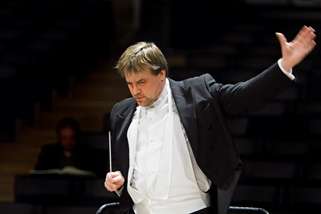|
Back
Storgårds and Sibelius excel Ottawa
Southam Hall, National Arts Centre
05/25/2016 - & May 26, 2016
Johann Sebastian Bach: The Musical Offering, BWV 1079: Ricercare in six voices (arr. Anton Webern)
Wolfgang Amadeus Mozart: Piano Concerto No. 17 in G major, K. 453
Jean Sibelius: Symphony No. 1 in E minor, Op. 39
Marc-André Hamelin (piano)
National Arts Centre Orchestra, John Storgårds (conductor)

J. Storgårds (© Heikki Tuuli)
Principal guest conductor John Storgårds lead the National Arts Centre Orchestra’s (NACO) penultimate subscription pair for the 2015-16 season this week, delivering an enlightening evening of obscure Bach (via Webern), Mozart’s Piano Concerto No. 17 and Sibelius’ ambitious and stunningly brilliant Symphony No. 1.
The Sibelius was the evening’s high point, a work created just before the start of the 20th century when the composer was 33, and a symphonic debut which often reflected other composers, notably Bruckner and Tchaikovsky (who in turn had reflected Beethoven and others before them). Like Sibelius, Storgårds is a native of Finland and clearly relishes the work of his home country’s most celebrated creative musician. The conductor has demonstrated before here that he likes a warm, beefy sound from his players and this sensibility is a perfect match for the Sibelius. From the sinewy clarinet theme which opens the work, leading to an organically evolving main theme, brief moments with flutes and harp then a stormy development, Storgårds at once displayed solid command of his players in musical and technical terms. A more lyrical interlude then final climax left listeners eager for more, and the conductor never disappointed them.
Haunting strings initiate the second movement, paying conspicuous tribute to the mid-section of the corresponding movement from Tchaikovsky’s Symphonie Pathétique, composed five years earlier, while further dialogue encompasses a brief cello solo (excellent work from associate principal Rachel Mercer), then harp and piccolo in tandem. The third movement Scherzo is an impressively respectful and ambitious salute to Bruckner, often but not always in ‘pounding’ mode, with a more lyrical mid-section reflecting the preceding movement. The closing Finale (Quasi una fantasia) almost melds Bruckner and Beethoven (not to mention borrowing a titular directive from Beethoven’s most popular Piano Sonata of all time [yes, the Moonlight]). The melodramatic opening strings usher a mood of constant contrasts between winds and brass, always gaining momentum and intensity but never losing control – Sibelius displayed remarkable discipline and control here, revealing a sturdy classicism in addition to his romantic and programmatic propensities, which again suggested Tchaikovsky.
Maestro Storgårds brought everything to a vigorous, finely calibrated conclusion – so much that he teased listeners, remaining poised and still when the performance had ended, causing some eager applauders to silence themselves until he turned around and quite literally conducted the audience, signalling that applause now would be appropriate and welcome.
Discreet laughter soon morphed into a standing ovation.
The past NACO season has had no shortage of fine symphonic performances – two Dvorák Symphonies in recent weeks via guest conductors Nikolaj Znaider and Rafael Payare, as well as Mahler and Bizet with music director Alexander Shelley on the podium. Storgårds’ Sibelius this week is a worthy continuation of these.
The program’s first half was interesting, opening with Anton Webern’s arrangement for small orchestra of the Ricercare in six voices from Bach’s seldom performed The Musical Offering – offhand, this reviewer cannot recall a live performance since Anton Kuerti included it in a piano recital in 1971, though Kuerti (who played two of the Ricercare) didn’t bother to cite The Musical Offering in that concert’s printed program (but cried foul when critics also neglected to mention it). The Webern arrangement is controversial, moving beyond merely transcribing existing counterpoint to sometimes assigning notes of a single canonic strand to different instruments – cute but not likely what Bach ever imagined. In the end, the arrangement enables warmth and dissonance equally and seems almost like something Glenn Gould might have written had Webern not beaten him to it.
The evening’s other major work was Mozart’s Piano Concerto No. 17 with Canadian pianist Marc-André Hamelin as soloist. Hamelin is best known for flashy, virtuoso repertoire (Liszt and Scriabin, of late), however brought impressive delicacy to the Mozart in this week’s performance, starting with an immaculately realized first subject. Regrettably, he and conductor Storgårds did not seem in agreement regarding tempos (Hamelin was constantly rushing) and the orchestra’s decidedly big sound too often drowned him out totally. It wasn’t that the orchestra was too loud per se, but rather the sound was just too rich and dense – Storgårds indicated similar problems here last January when American virtuoso Garrick Ohlsson performed Beethoven’s Piano Concerto No. 4 with NACO.
Hamelin projected well during solo work, especially the first movement cadenza and the slow movement’s extended solo which encompasses a rich range of texture, harmonics and mood, at one point foreshadowing Chopin’s Prelude in E Minor. There were further tempo and balance problems during the final movement. With so many unresolved issues between soloist and conductor this was, while not what could be called a bad performance, nonetheless an unsatisfactory one, even though the actual playing was often excellent.
This was not a perfect evening, but overall an engaging one with interesting if challenging performances during the first half, then a stunning Sibelius performance for the second.
Charles Pope Jr.
|